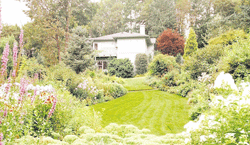By Hosea Omole
Many novice landscapers take to work without a clear picture of how they want the garden to eventually look. Many others merely recreate elements they have seen elsewhere and, once in a while, accidentally or otherwise, end up with something that actually works, even aesthetically sound.
 |
African native garden. Photo: Courtesy/Standard |
Often, however, the garden ends up looking like a collection of unrelated concepts devoid of any unifying theme or language. Although the only real limit to the type of garden you can have is your imagination, working with a style that strings through all your elements is still important. Take some time to understand the philosophy behind any style before trying it out in your garden. This helps you to stay on top of your preferences and to creatively control any adaptations to your own style.
Adopting a native landscape style is both unique and ecologically sound. Garden dÈcor designed to incorporate artefacts from the local culture gives the garden a sense of belonging. The use of local planting materials has also been found to provide refuge for local animal species, thereby, sustaining the ecological balance in the area. Here are the basics of setting up a native garden:
Planting materials
Kenya has a diversity of ecosystems and climates — from the highlands to the coastal lowlands and the semi-arid lands. Not all Kenyan plants will, therefore, be suitable for your garden. The best approach is to choose plants that naturally grow in your immediate surroundings. If you have to search further, consider those that do well in conditions similar to yours. A bit of precaution should, however, be taken to avoid wild and poisonous plants.
Visit a local plant nursery and enquire about any local species in stock. Choose those with colourful leaves, flowers, fruits and nuts. Try and get at least three seedlings of each kind and plant them in odd-numbered groups, avoiding any patterns. If you can get any, incorporate some multi-functional plants to give your garden added utility such as shade, food, soil enrichment and wildlife attraction.
Remember that local plants also need some ground preparations prior to planting. Take note of your soil type and adjust to suit the chosen plants. You may need to add some manure and water to increase the plants’ chances of survival.
Construction materials
Materials used in the native gardens should reflect the natural landscape of your area. Any paths, rabble wall or retaining wall should as much as possible be made of natural stones from the surroundings. Also let the landscape characters influence your garden design. If your area has a rocky terrain, then you have the perfect excuse to include a rock garden using boulders from the neighbourhood.
Hard capes such as gazebos should be constructed using local materials and concepts. Instead of concrete columns and roofing tiles, it may be better to use local hardwood poles and makuti roofing to match the rest of your native garden.
Furniture and dÈcor
If you wish to add outdoor furniture and dÈcor, have them made to mimic traditional artefacts. Reed outdoor furniture and decorations are great both functionally and culturally. Local carvings and statues can be customised to your taste. They are great for accentuating important areas in your garden. They also unlock a perfect opportunity for self-expression.
The writer is a professional landscape architect.
 The Standard Group Plc is a multi-media organization with investments in media
platforms spanning newspaper print operations, television, radio broadcasting,
digital and online services. The Standard Group is recognized as a leading
multi-media house in Kenya with a key influence in matters of national and
international interest.
The Standard Group Plc is a multi-media organization with investments in media
platforms spanning newspaper print operations, television, radio broadcasting,
digital and online services. The Standard Group is recognized as a leading
multi-media house in Kenya with a key influence in matters of national and
international interest.
 The Standard Group Plc is a multi-media organization with investments in media
platforms spanning newspaper print operations, television, radio broadcasting,
digital and online services. The Standard Group is recognized as a leading
multi-media house in Kenya with a key influence in matters of national and
international interest.
The Standard Group Plc is a multi-media organization with investments in media
platforms spanning newspaper print operations, television, radio broadcasting,
digital and online services. The Standard Group is recognized as a leading
multi-media house in Kenya with a key influence in matters of national and
international interest.










